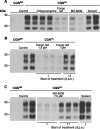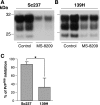Prion strain- and species-dependent effects of antiprion molecules in primary neuronal cultures
- PMID: 17913812
- PMCID: PMC2168876
- DOI: 10.1128/JVI.01502-07
Prion strain- and species-dependent effects of antiprion molecules in primary neuronal cultures
Abstract
Transmissible spongiform encephalopathies (TSE) arise as a consequence of infection of the central nervous system by prions and are incurable. To date, most antiprion compounds identified by in vitro screening failed to exhibit therapeutic activity in animals, thus calling for new assays that could more accurately predict their in vivo potency. Primary nerve cell cultures are routinely used to assess neurotoxicity of chemical compounds. Here, we report that prion strains from different species can propagate in primary neuronal cultures derived from transgenic mouse lines overexpressing ovine, murine, hamster, or human prion protein. Using this newly developed cell system, the activity of three generic compounds known to cure prion-infected cell lines was evaluated. We show that the antiprion activity observed in neuronal cultures is species or strain dependent and recapitulates to some extent the activity reported in vivo in rodent models. Therefore, infected primary neuronal cultures may be a relevant system in which to investigate the efficacy and mode of action of antiprion drugs, including toward human transmissible spongiform encephalopathy agents.
Figures





Similar articles
-
Prions can infect primary cultured neurons and astrocytes and promote neuronal cell death.Proc Natl Acad Sci U S A. 2004 Aug 17;101(33):12271-6. doi: 10.1073/pnas.0402725101. Epub 2004 Aug 9. Proc Natl Acad Sci U S A. 2004. PMID: 15302929 Free PMC article.
-
Non-genetic propagation of strain-specific properties of scrapie prion protein.Nature. 1995 Jun 22;375(6533):698-700. doi: 10.1038/375698a0. Nature. 1995. PMID: 7791905
-
Inhibition of formation of protease-resistant prion protein by Trypan Blue, Sirius Red and other Congo Red analogs.Arch Virol Suppl. 2000;(16):277-83. doi: 10.1007/978-3-7091-6308-5_26. Arch Virol Suppl. 2000. PMID: 11214931
-
Insights into Mechanisms of Transmission and Pathogenesis from Transgenic Mouse Models of Prion Diseases.Methods Mol Biol. 2017;1658:219-252. doi: 10.1007/978-1-4939-7244-9_16. Methods Mol Biol. 2017. PMID: 28861793 Free PMC article. Review.
-
Prion diseases: what is the neurotoxic molecule?Neurobiol Dis. 2001 Oct;8(5):743-63. doi: 10.1006/nbdi.2001.0433. Neurobiol Dis. 2001. PMID: 11592845 Review.
Cited by
-
Two distinct conformers of PrPD type 1 of sporadic Creutzfeldt-Jakob disease with codon 129VV genotype faithfully propagate in vivo.Acta Neuropathol Commun. 2021 Mar 25;9(1):55. doi: 10.1186/s40478-021-01132-7. Acta Neuropathol Commun. 2021. PMID: 33766126 Free PMC article.
-
Highly infectious prions generated by a single round of microplate-based protein misfolding cyclic amplification.mBio. 2013 Dec 31;5(1):e00829-13. doi: 10.1128/mBio.00829-13. mBio. 2013. PMID: 24381300 Free PMC article.
-
Comparison of abnormal isoform of prion protein in prion-infected cell lines and primary-cultured neurons by PrPSc-specific immunostaining.J Gen Virol. 2016 Aug;97(8):2030-2042. doi: 10.1099/jgv.0.000514. Epub 2016 Jun 6. J Gen Virol. 2016. PMID: 27267758 Free PMC article.
-
Endogenous proteolytic cleavage of disease-associated prion protein to produce C2 fragments is strongly cell- and tissue-dependent.J Biol Chem. 2010 Apr 2;285(14):10252-64. doi: 10.1074/jbc.M109.083857. Epub 2010 Feb 12. J Biol Chem. 2010. PMID: 20154089 Free PMC article.
-
Cellulose ether treatment in vivo generates chronic wasting disease prions with reduced protease resistance and delayed disease progression.J Neurochem. 2020 Mar;152(6):727-740. doi: 10.1111/jnc.14877. Epub 2019 Oct 16. J Neurochem. 2020. PMID: 31553058 Free PMC article.
References
-
- Bach, S., N. Talarek, T. Andrieu, J. M. Vierfond, Y. Mettey, H. Galons, D. Dormont, L. Meijer, C. Cullin, and M. Blondel. 2003. Isolation of drugs active against mammalian prions using a yeast-based screening assay. Nat. Biotechnol. 21:1075-1081. - PubMed
-
- Benito-Leon, J. 2004. Combined quinacrine and chlorpromazine therapy in fatal familial insomnia. Clin. Neuropharmacol. 27:201-203. - PubMed
Publication types
MeSH terms
Substances
LinkOut - more resources
Full Text Sources
Other Literature Sources

